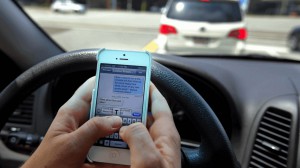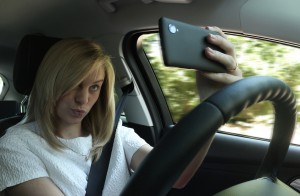It’s not your imagination. In spite of concerted efforts by federal agencies and safety advocacy groups, Americans are spending more time than ever using their phones while behind the wheel.
According to a new study by Zendrive, a San Francisco-based startup that tracks phone use for auto insurers and ride-hailing fleets, two out of every three drivers uses their cell phones at least once during a trip in their vehicle.
This can be as simple as taking a phone call or as dangerous as texting. Zendrive monitored 4.5 million drivers from December through February, who travelled 7.1 billion miles, comparing the results with the year-earlier period.
For the drivers that picked up their phones, they used them for an average of almost four minutes, which is a 5% increase compared with last year’s results, the group said.
(East Coast drivers most distracted behind the wheel. Click Here for the story.)
“It might not seem like a lot, but even 10 seconds is very significant when you look at the number of people on the road,” Jonathan Matus, Zendrive’s founder, told Bloomberg News. Distracted drivers account for 26% of all crashes, according to the National Highway Traffic Safety Administration.
More importantly, Zendrive’s results show that the problem of distracted driving may be much worse than what the general public has been led to believe.
Zendrive says it’s 2018 Distracted Driving Snapshot reveals that 69 million drivers use their phones behind the wheel every day, which far more than the 660,000 daily distracted drivers reported by NHTSA.
Nationwide, Zendrive found in 2018:
- Distracted driving increased in every state, except for Vermont.
- Driver phone use also increased in every city it studied.
- The average duration of phone use also increased.
At any given hour of the day, an average of 40% of drivers use their phone at least once. This average rises to 72% when looking at drivers who use their phone at least once between 10 a.m. to 5 p.m., according to the study.
Overall, drivers use their phones for an average of 1-minute, 52-seconds of every hour behind the wheel. At 55 mph, this is like driving 1.2-miles blindfolded, or the length of 21 football fields.
However, this stat also takes into account the drivers who don’t use their phones at all. When looking only at drivers who use their phones at least once, this average doubles, shooting up to three minutes and 40 seconds of every hour. At 55 mph, this is like 42 football fields blindfolded.
(Click Here for more about safety groups joining forces to push reforms.)
“As you have more young drivers on the road, and as people increasingly become addicted to their smartphones, it will continue being a major health issue—almost an epidemic—in this country,” Matus told Bloomberg.
The study reveals that there is no simple way to change the habits of drivers in the U.S. as the problem got worse in every state but one — Vermont. In fact, in all 14 states that ban using handheld phones while driving, the behavior worsened.
In Mississippi and Rhode Island, the worst states for distracted driving, subject drivers spent almost 8% of their time on the phone. Oregon and Montana drivers spent the smallest amount of time on their phones.
The worst city was Houston followed by Miami and Detroit. Seattle and Portland, Oregon, were the best. Those with iPhones used their devices far more often, and far longer, than those on Android-based handsets.
Phone use peaks around 4 p.m., when three out of four drivers, on average, are stealing a peak at their screens, perhaps trying to beat traffic and finish work at the same time. It drops steadily through the night, though drivers who use phones just before midnight tend to stay on them the longest, more than four minutes at a time.
The vast majority of phone use is in the first 5% of a trip, right when people are getting going. The worst time overall for distracted driving is at night, from 9 p.m. to midnight, when drivers use their phones for an average of 30 seconds longer — an increase of 20%.
(To see more about how traffic fatalities fell slightly in the first half of 2017, Click Here.)
And holidays are even worse. During Christmas Eve, Christmas Day, New Year’s Eve, and New Year’s Day, Super Bowl Sunday and Valentine’s Day as drivers use their phones 15%, or 9 seconds, more than average.



We need a device/chip/software in vehicles and/or cell phones that disables/shuts off the the other when started/turned on.
It took decades to get (most) people to wear seatbelts. Wonder how long this is going to take.
There’s no shortage of laws now. The problem is that
too many feel that they’re the Exception to the Laws.As Allen said,”most but not all wear their seat belts,UNTIL a police officer is behind them!